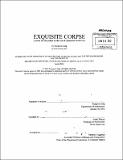Exquisite corpse: a tower for the public in the era of exhausted modernity
Author(s)
Jang, Sungwoo
DownloadFull printable version (6.896Mb)
Alternative title
Exquisite corpse: building a tower for the public in an era of exhausted modernity
Other Contributors
Massachusetts Institute of Technology. Dept. of Architecture.
Advisor
Nader Tehrani.
Terms of use
Metadata
Show full item recordAbstract
Towers in Manhattan, especially in business areas, have historically used a single overarching system in order to visualize images of their corporate identity and immerse the public in the image of development. While using one system, the architect has tried to organize various unexpected behavior with those system. Thus, the grid system, whose representational value was important as much as its economic value, not only deformed the physical form of different function, but also prevented certain functions which did not match with their corporate identity to be incorporated into the tower. However, entering into an era of uncertainty due to economic crisis, 9/11 terror and etc., resulted in overarching system to become obsolete not because of its lack of efficiency, but because those systems have lost its representational value as an emblem of progress. As vision of progress have lost its momentum to suppress other values, in the era of exhausted modernity, it is unnecessary to deform the physical form of each function, in other words, each program can be incorporated into the tower without losing its irreducible form. Also, programs which takes a huge part of our culture that have been excluded can be introduced - or, the re-union of Apollo and Dionysus in city culture. In this situation, the grid system needs to operate not as an overarching system which represses the irreducible form of each program, but rather a tool that orchestrates multiple different forms that produces the collection of programs to become an image of a deceptive whole. By doing so, different functions will not only be legitimized to be incorporated within the typology of tower, but also it would produce an image based on the heterogeneity, thus becoming a new ethic.
Description
Thesis (M. Arch.)--Massachusetts Institute of Technology, Dept. of Architecture, 2012. Cataloged from PDF version of thesis. Includes bibliographical references (p. 40).
Date issued
2012Department
Massachusetts Institute of Technology. Department of ArchitecturePublisher
Massachusetts Institute of Technology
Keywords
Architecture.